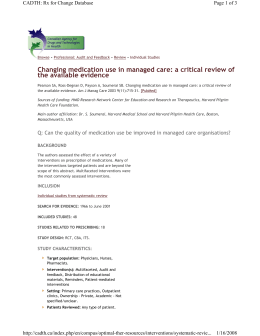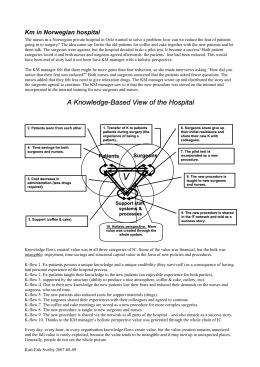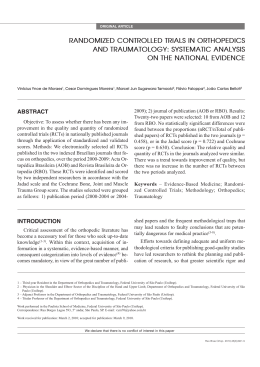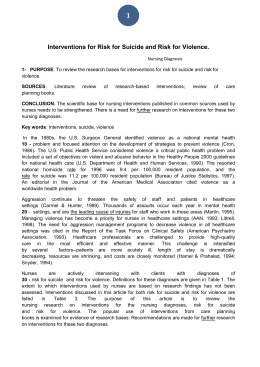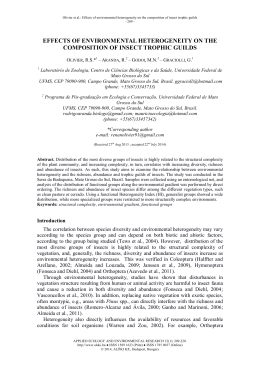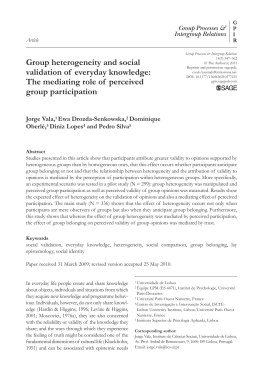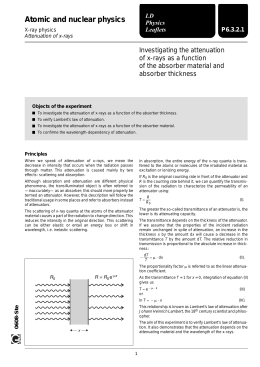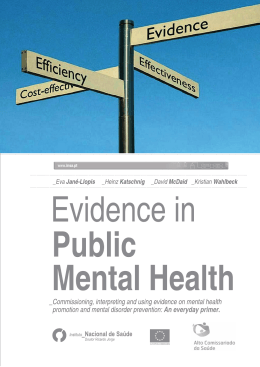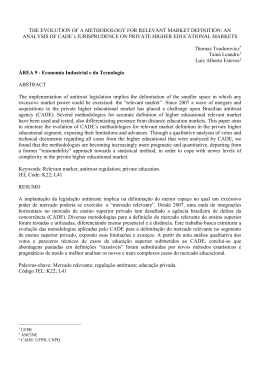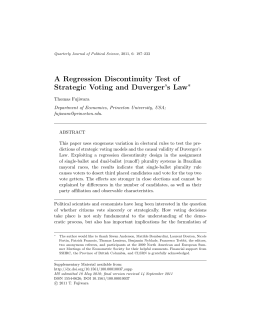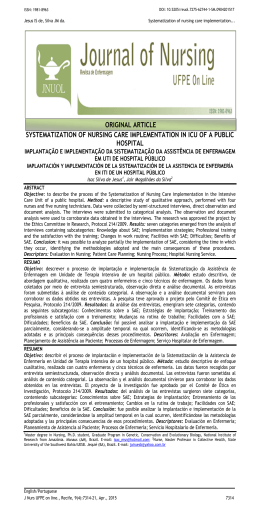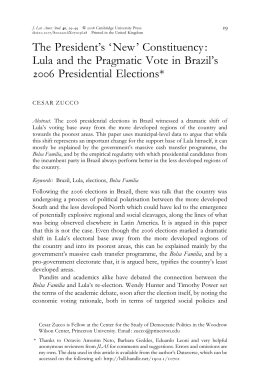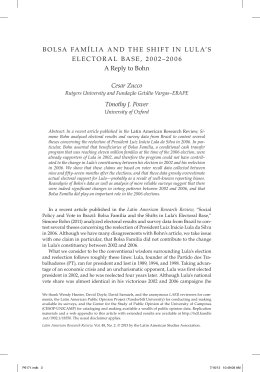CADTH: Rx for Change Database Page 1 of 3 Browse » Organizational: Revision of Professional Roles - Nursing » Review » Individual Studies Substitution of doctors by nurses in primary care Laurant M, Reeves D, Hermens R, Braspenning J, Grol R, Sibbald B. Substitution of doctors by nurses in primary care. Cochrane Database Syst Rev 2005 (2):CD001271. [PubMed] Sources of funding: No funding or perceived conflict of interest Main author affiliation: Dr. M. Laurant, University of Nijmegen, Nijmegen, Netherlands Q: Is physician-nurse substitution in primary care effective for improving patient outcomes, process of care, resource utilization, and costs? BACKGROUND The focus of this review was on nurses functioning as substitutes for physicians in the primary care setting, whereby the tasks formerly performed by physicians are transferred to nurses. The performance of the two clinician groups are then compared. INCLUSION Individual studies from systematic review SEARCH FOR EVIDENCE: Up to 2002 INCLUDED STUDIES: 16 STUDIES RELATED TO PRESCRIBING: 8 STUDY DESIGN: RCT, CBA. STUDY CHARACTERISTICS: Target population: Nurses, Physicians. Intervention(s): Revision of professional roles - Nursing. Setting: Communities, Not stated (primary care settings). Patients Reviewed: Not specified, Specific diagnose or clinical condition, Other, Drug Related Outcome Categories: Appropriate use, Appropriate use - choice. Other Outcome Categories: Professionalpatient communication, Test ordering, Referrals, Other, Other resource use, http://cadth.ca/index.php/en/compus/optimal-ther-resources/interventions/systematic-revie... 1/16/2008 CADTH: Rx for Change Database Page 2 of 3 AUTHORS' ANALYSIS OF DATA: Vote counting based statistical significance, Metaanalysis. REVIEW QUALITY: 8 RESULTS - OVERALL A substantial reanalysis of this review was undertaken. Although authors do not specify the actual settings in the included studies, of interest to the review were primary care settings (excluding accident and emergency). Authors identified that unit of analysis errors were an issue in only a few studies. The majority of included studies were RCTs, and of those, authors state it is unclear whether contamination occurred. Small numbers of nurses were included in these studies, and most studies also included small numbers of physicians, if at all reported. Nurses substituting doctor care was generally ineffective for improving appropriate care (n=16), although over half of the included studies reported mixed results among reported outcomes. Fixed-effects meta-analyses for a number of outcomes were conducted; behaviours range from generally ineffective to generally effective with a range in effect sizes from no effect to medium effect sizes, but few studies were located (n=3 for each metaanalysis). RESULTS - RELATED TO PRESCRIBING A subset of included studies evaluated prescribing-related outcomes. Nurses substituting doctor care was generally ineffective for improving appropriate use (n=7). No effect size was shown with the meta-analysis (n=3). Insufficient evidence exists for appropriate use - choice (n=1). CONCLUSIONS - OVERALL High quality review. Nurses substituting doctor care was generally ineffective for improving appropriate care, although over half of the studies reported mixed results. CONCLUSIONS - RELATED TO PRESCRIBING High quality review. Nurses substituting doctor care was generally ineffective for improving appropriate use. EFFECTIVENESS High quality review. Revision of professional roles Nursing was generally ineffective for improving appropriate care, including for the appropriate use of prescribing. http://cadth.ca/index.php/en/compus/optimal-ther-resources/interventions/systematic-revie... 1/16/2008 CADTH: Rx for Change Database Page 3 of 3 Table of Results Comparison Outcome N Analysis Results Nurse care vs doctor care Appropriate care 16 Vote counting based on direction of effect. RD (95% CI) from metaanalysis. Vote counting 1/16 studies (mixed designs) favoured intervention and 9/16 studies reported mixed results: generally ineffective. 3/16 studies had only patient outcome data available. Vote counting 1/13 RCTs favoured intervention and 8/13 reported mixed results: generally ineffective. Meta-analyses (fixed effects, 3 RCTs each, pooled RD) Scheduled return visits: 2/3 RCTs favoured intervention, RD 7% (CI 4% to 10%; H p=0.002, I2=83.7%). Mixed effects with medium effect sizes. High heterogeneity. Prescriptions ordered: 2/3 RCTs favoured intervention, RD 0% (CI -3% to 2.5%; H p=0.23, I2=31.3%). Mixed effects with no effect size. Low heterogeneity. Hospital referral: 1/3 RCTs favoured intervention, RD 0.2% (CI -0.07% to 0.4%; H p=0.13, I2=51.5%). Generally ineffective with no effect size. Moderate heterogeneity. Attendance at accident & emergency: 3/3 RCTs favoured intervention, RD 0.3% (CI 1% to 0.42%; H p=0.93, I2=0%). Generally effective with no effect size. No to minimal heterogeneity. Hospital admission: 2/3 RCTs favoured intervention, RD 1% (CI 0.2% to 1.9%; H p=0.19, I2=39.7%). Mixed effects with small effect sizes. Low heterogeneity. Prescribing-related outcomes (n=8): APPROPRIATE USE: Vote counting 1/7 studies (mixed designs) favoured intervention: generally ineffective. Vote counting 0/5 RCTs favoured intervention: generally ineffective. Meta-analysis (above) pooled RD 0%: no effect size. APPROPRIATE CHOICE: Vote counting 0/1 RCTs favoured intervention: insufficient evidence. Notes: H=heterogeneity Top of Page Privacy Policy Feedback Terms of use © 2008 Canadian Agency for Drugs and Technologies in Health Last Updated January 7, 2008 http://cadth.ca/index.php/en/compus/optimal-ther-resources/interventions/systematic-revie... 1/16/2008
Download
